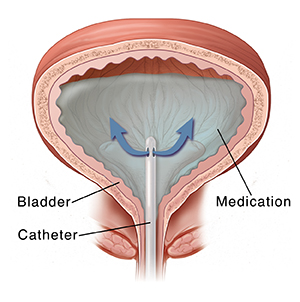Treating Bladder Cancer: Intravesical Therapy
Treating Bladder Cancer: Intravesical Therapy
Some types of bladder tumors are hard to remove completely with surgery. They may happen in more than one area and they may be flat against the bladder wall. They may have come back after treatment. Or, the bladder tumors may have been very small and removed during a transurethral resection of bladder tumor (TURBT), but there's concern they may come back. In these cases, special medicines that kill cancer cells may be put right inside the bladder. This is called intravesical therapy. It may be a choice if you have a hard-to-remove tumor. Or it may be done after surgery to help keep the cancer from coming back.
Medicine inside your bladder
Intravesical therapy is often done in a healthcare provider’s office or outpatient clinic. A thin, flexible tube (catheter) is passed through the urethra and into the bladder. The catheter is used to fill the bladder with a liquid medicine. This may be a liquid chemotherapy medicine. Or it may be BCG (Bacillus of Calmette and Guerin). This is a type of bacteria that helps boost your body’s immune system so that it kills the cancer cells.
During treatment
You will need to hold the medicine in your bladder for 2 hours. In some cases, the catheter may be left in and the medicine is removed through it when treatment is done. In other cases, the catheter is taken out after the medicine is put in. Then you will urinate after the 2 hours are over. If BCG is used, you may need to pour bleach in the toilet after you urinate. This kills any bacteria that may be left over. Intravesical therapy is given weekly for 6 to 8 weeks. During this time, you may be given antibiotics. This is to help prevent infection. It will depend on the medicine that is used for you.
After treatment
After your initial BCG treatment, you may need to have follow-up treatments for up to a year or more. This is called maintenance BCG. These help keep the cancer from coming back. When all the treatments are done, you may have tests done every few months to help check for cancer cells.
Risks and possible complications
The following are possible side effects of this treatment:
Bladder infection
Blood in the urine
Bladder irritation (burning, need to urinate often, pain on urination)
Flu-like symptoms, such as fever and chills
Scarring of the bladder (rare)
General infection (with BCG) (very rare)
When to call your healthcare provider
Call your healthcare provider right away if you develop a fever of 100.4°F (38°C) or higher. Be sure you know what other problems you should watch for, and know how to get help any time, including after office hours, on weekends, and on holidays.
Updated:
June 23, 2018
Sources:
NCCN Guidelines Bladder Cancer Version 2.2015. National Comprehensive Cancer Network
Reviewed By:
LoCicero, Richard, MD,Stump-Sutliff, Kim, RN, MSN, AOCNS
